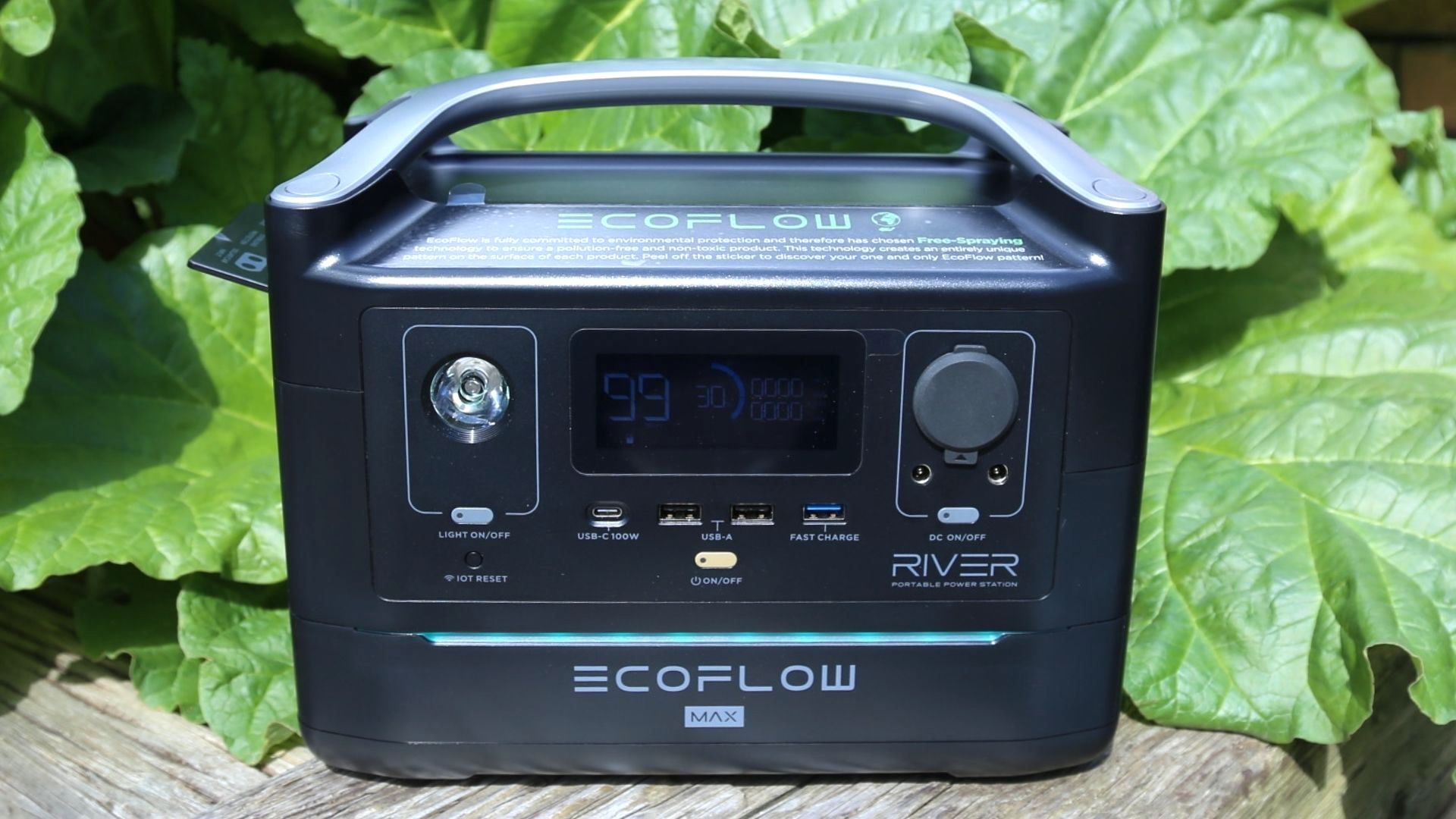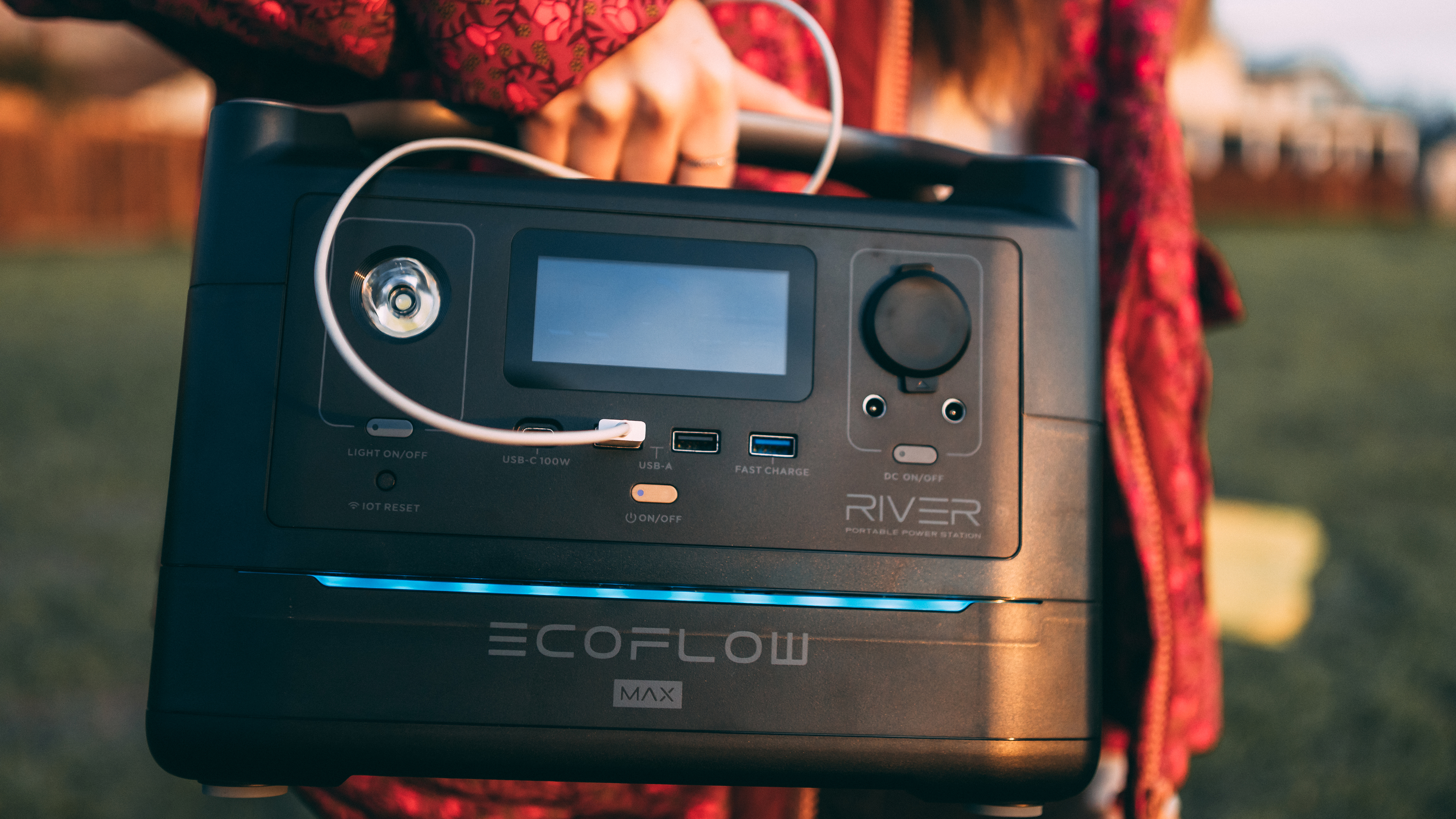EcoFlow RiverMax portable power station review: versatile hub for camping
The EcoFlow River Max portable power station is insanely fast to charge at home and can even run TVs and home appliances


The EcoFlow RiverMax portable power station isn’t just for keeping smartphones and tablets charged when off-grid. Capable of running everything from fridges to power tools it can be charged-up from empty at home in just 96 minutes and even while you’re driving to your destination.
-
+
Charges in 96 minutes
-
+
Extra battery is removable
-
+
100W USB-C power delivery for laptops
-
+
Can cope with TV and home appliances
-
+
Built-in LED light
-
-
Expensive
-
-
Relatively small capacity
-
-
Lacks wireless charging pads
Why you can trust T3

The EcoFlow River Max portable power station reviewed here is for weekends away camping when you want to take your home comforts with you. Though it’s packed with USB outputs to recharge smartphones, tablets and laptops the River Max is just as able to fuel a TV, a power tool or a hairdryer.
It’s also rather unusual in that its considerable – though easily portable – 7.7kg/17lbs weight can be slashed simply by removing one of its two 288Wh batteries for occasions when you want to prioritise portability over power.
Here’s why we think that the River Max is the best portable power station you can buy, a great travel companion for short trips to the countryside and anywhere away from mains electricity.

EcoFlow River Max portable power station review: price and release date
Originally launched in February 2021, River Max sells for UK£549/US$599/AUS$1,199 and is part of EcoFlow’s River Series, which comprises the EcoFlow River (288Wh), River Max (576Wh) and River Pro (720Wh). They’re all portable, entry-level products and all can power devices that require up to a whopping 1800W.
River and River Max have the same chassis and use 288Wh batteries, so River can easily be upgraded to River Max, and vice versa. In October 2021 EcoFlow announced the River Mini (210Wh), which supports AC input up to 600W.
Also available for use with the River Series are 110W and 160W solar panels, which are often bundled with the River products. (For more sun-powered solutions, check out best solar charger roundup.)

EcoFlow River Max portable power station review: features and what’s new
At first glance, the River Max is all about fast charging. While your average portable power station promising in the region of its 576Wh will take about six hours to recharge when plugged into the mains (something you’re always going to do before leaving home to go off-grid), the River Max takes a spectacularly short 96 minutes.
Get all the latest news, reviews, deals and buying guides on gorgeous tech, home and active products from the T3 experts
It’s a staggered process, so it gets to a “that’ll do” 80% in just an hour then slows down. That’s down to EcoFlow's X-Stream, a smart inverter that powers its two separate 288Wh batteries that recharge simultaneously.
EcoFlow River Max portable power station: specs
Capacity: 576Wh
Weight: 7.7kg/17lbs
Measurements: 289x184x235mm/11.4x7.3x9.3”
Solar: 200W
Outputs: 1x USB-A fast-charge (18W), 2x USB-A (5V/2.4A), 1 x USB-C (100W), 1x 13.6V cigarette lighter, 2x AC (600W), 2x DC
Inputs: 1x 12V, 1x AC (500W)
You can also recharge it via either a solar panel or a 12V car input (what used to be called a cigarette lighter), which takes five hours – so doable on a road trip.
It also supports solar and car input, both up to 100W. It takes between five and 10 hours to fully recharge from a couple of 110W solar panels or from one 160W solar panel.
Its 2,000W pure-sine wave AC inverter is pretty handy, too; you can also increase the AC output to up to 1800W if you need to power a home appliance – such as a heater, a mini-fridge or a cinema projector (why not?) – or a DIY tool. Even better, it has two AC sockets.

EcoFlow River Max portable power station review: set-up and use
Plug the River Max into the mains via a standard kettle lead and, yes, it gets charging quick-smart. It makes a loud beep as it does, and lights up not only a strip of green LEDs on its front, but also shows a blue circle of lights whizzing around a % figure showing exactly how much of the battery is charged.
Besides that is the number of minutes until it’s going to be fully charged. It won’t be long. From being 50% charged it took under an hour to get to 100% without getting hot, though it did make an audible humming noise. We also noticed that the last few percent of the battery appeared to take over 10 minutes to fill.
Something else we noticed about the River Max’s otherwise excellent LCD display is that it gives you a figure in hours for how long it will take to recharge or how long until it’s going to be empty on current usage. That’s not incredibly helpful; a more exact figure in hours and minutes would be more useful.
What we liked about the River Max is its ease of installation. You can loosen four screws and remove the bottom half of the product to halve its battery power (and its weight). Either way it’s fairly portable, though an excellent built-in X-shaped carry handle makes it easy to transfer from car to camp.
Underneath that handle is a small recessed area that’s about the same size as a smartphone; what a shame there’s no wireless charging pad there. What it does have is an LED light, though you can’t change its angle so it’s of limited use around camp.
The app is pretty simple, letting you know exactly what's being used and how much power River Max is sending through each output. It also lets you switch off that horrible beep.

EcoFlow River Max portable power station review: performance
We tested everything we could find with the River Max, from phones and laptops via its suite of USBs to a vacuum cleaner, a hairdryer, a heater and even a 20-inch TV (which worked for about nine hours) via its two AC inputs. It didn’t miss a beat, the only very slight downside being that it makes a humming noise when in use. It’s not loud (we clocked it at 35 decibels), but noticeable… though nothing compared to traditional generators.
Slightly more annoying is the fact that its LED green indicators pulse rather brightly during use, and that everything you press – be it buttons to switch on AC, DC and USB outputs, or the LED light – elicits a loud beep. Happily, you can disable both the beeps and the lights via the app.
We also loved its modular design. Though being able to downgrade a portable power station seems like an odd advantage, it’s genuinely helpful to be able to remove one of the River Max’s 288Wh lithium-ion NMC batteries to leave it substantially lighter. After all, if you’re only going for a couple of nights’ camping and all you’re taking is a phone there’s no need to overdo it.

EcoFlow River Max portable power station review: verdict
If you can’t decide whether you need a grab-and-go portable battery for weekends away or something more substantial then the modular EcoFlow River Max is hugely attractive. In fact, we think it's the best portable power station you can buy. Its total of 576Wh is more than enough for most people camping or going off-grid for a few days, but the ability to remove one of its two batteries to lessen the weight is helpful. However, what we love most about the River Max is how fast it is to charge; you no longer have to prepare 24 hours in advance for trips away. Add its ability to cope with a TV and home appliances as well as multiple phones and small devices and the River Max has a catch-all appeal for short-haul off-grid trips.
EcoFlow River Max portable power station review: alternatives to consider
Almost identical to the EcoFlow River Max, though a little lighter is the Jackery Explorer 500, which has a similar set of ins and outs yet weighs 6kg and offers a similar 518Wh. However, if you want to go the other way and set-up camp off-grid for weeks on end then consider the Goal Zero Yeti 1500X, which gives 1,516Wh – enough to charge fridges and lights – though it weighs a hefty 20.7kg.
Jamie is a freelance journalist, copywriter and author with 20 years' experience. He's written journalism for over 50 publications and websites and, when he's not writing, spending most of his time travelling – putting the latest travel tech through its paces.
